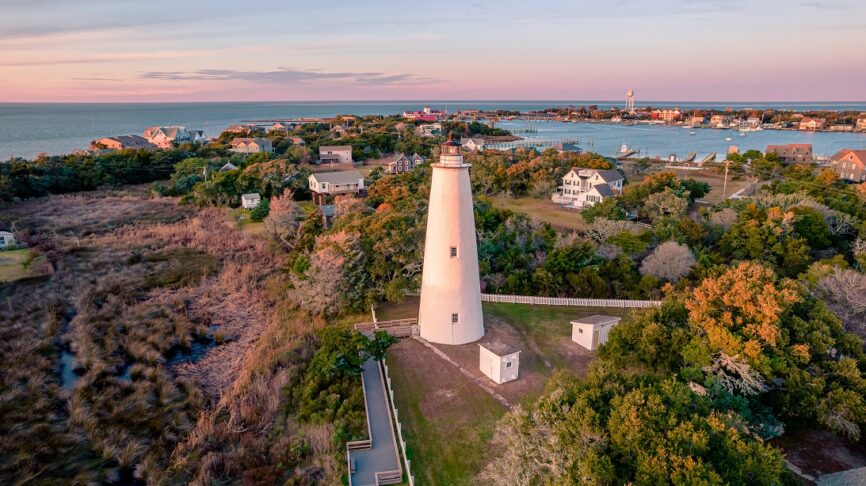
Ocracoke Lighthouse
The Ocracoke Lighthouse, located in Ocracoke Village, stands 75 feet tall and has been guiding mariners through the Ocracoke Inlet since 1822. Ocracoke is a small island south of Hatteras and north of Portsmouth Island. To get to the Ocracoke Lighthouse, you have to ride a ferry through the Hatteras Inlet, and then continue driving to the southern end of Ocracoke Island. Visitors are not able to climb the Ocracoke Lighthouse due to safety concerns with the 200+ year-old spiral staircase, but it remains a fascinating piece of history to see. Its white exterior differentiates it from the other lighthouses along the Outer Banks.
Ocracoke Inlet is a bit of an oddity. It is the only permanent inlet on the Outer Banks—at least there has been an inlet between Ocracoke and Portsmouth Island since the first European maps were drawn. There is an ancient river bed beneath the waters that accounts for its permanence.
It was, at one time, one of the most important passages to North Carolina ports. So important that, as early as 1715, the inlet was declared an official point of entry to the inner banks’ towns of Edenton, Bath, Washington, and New Bern and a harbor pilot was required for ships crossing the sounds. It was largely because of that designation, that ships had to have a pilot, that Ocracoke became a seaport in the 1700s. It is also why Blackbeard used the village as a base of operations.
By 1783 when the 13 British colonies signed the Treaty of Paris with Great Britain and officially became the new nation of the United States, Ocracoke Inlet was the only way to reach the ports of northeastern North Carolina.
One of the first acts of the nascent US Government was the Lighthouse Act of 1789, and in 1794 funds were allocated for a lighthouse at Ocracoke Inlet. Nine years later, in 1803, Shell Castle Island was an operational, if flawed, wooden lighthouse perched in the middle of Ocracoke Inlet.
When lightning struck the wooden tower in 1818, and it burned to the ground, no attempt was made to replace the Shell Castle Island Lighthouse, primarily because the channel had shifted.
The Federal government moved fairly quickly, allocating funds for a lightship. According to the Coast Guard Historian’s Office, setting aside $14,000 “for building a lighthouse on Shell Castle Island…or, in lieu thereof, a light vessel to be moored in a proper place near said island.”
The light from the lightship was widely criticized as too weak, and the channel was shifting. After spending $6625 on the lightship, Congress authorized a $50 payment for two acres on the south end of Ocracoke Island in 1820 and allocated $20,000 to build the new lighthouse. A contract to build a lighthouse was awarded to Massachusetts builder Noah Porter.
In a remarkable act of efficiency and honesty, Porter finished the project on time, and the cost was $11,359 in 1823.
The 69-foot tall tower still stands, a tribute to the skill of the builder. Perched on what is high ground for Ocracoke, the focal plane is 75 feet above sea level.
At its base, the Ocracoke Lighthouse diameter is 25 feet, tapering to 12 feet at the top. At ground level, the walls are five feet thick and two feet thick at the focal plane.
It is still an operating lighthouse, and according to the National Park Service, which owns the property, it is the second oldest operating lighthouse in the nation. There are other lighthouse locations that are older, but those structures are replacements for the original towers.

The Ocracoke lighthouse served a different role than most lighthouses. The flashing beacons of Cape Hatteras Lighthouse or Bodie Island warned mariners of dangerous shoals in the offshore waters.
Ocracoke was never intended to warn of shoaling waters; rather, its purpose was to urge caution as ships approached the bar or crossing of Ocracoke Inlet and not to attempt a crossing at night. Because its light was not intended to shine far out to sea, the light was never as powerful as most coastal lights.
The first light was an Argand oil lamp with parabolic reflectors. The Argand lamp was the invention of Aimé Argand, a Swiss inventor. His design allowed a more even flow of air to the wick, making oil lamps significantly brighter with a steadier flame than in the past.
At some point in time, someone, probably Argand, although that’s not certain, realized a parabolic reflector behind the lamp would greatly enhance its light, and Argand lamps with the reflectors became the standard for European and then American lighthouses.
In 1823 Augustin-Jean Fresnel invented his Fresnel lens. European governments quickly recognized it as superior to the Argand lamps, but inexplicably Stephen Pleasonton, the Fifth Auditor of the Treasury, who supervised the funding of the Lighthouse Service, continued to use the inferior Argand lamps, also called Lewis Lamps. In 1852 a newly created Lighthouse Board removed Pleasonton from his role and began placing Fresnel lenses in US lighthouses.
Two years later, in 1854, a fourth-order Fresnel lens was installed in the Ocracoke Lighthouse.
In 1862, hoping to make coastal navigation for Union forces more difficult, Confederate forces removed the lens. Two years later, though, the lighthouse was operational again with a new fourth-order lens.
By the early 1900s, technology had advanced to the point that an electric light was installed, although the Fresnel lens was still in use. However, there was still considerable maintenance needed, including ensuring the generator had fuel to power the light.
By 1946, however, the light became fully automated, and the Lighthouse Keeper position was eliminated.
The light still shines out to sea, warning mariners as far as 14 miles away of the danger of the Ocracoke bar. The light is a steady beam with no interruptions.
Most of the North Carolina coastal lighthouses were in remote locations, sometimes miles away from the nearest town. Bodie Island Lighthouse was a good ten miles from Nags Head, and that ten miles was across sand dunes, marsh, and beach.
But Ocracoke was a bit of an outlier in that regard.
“Due to the proximity of the village, the keepers and their families enjoyed a social life on Ocracoke, and their children were schooled in the village,” the National Park Service notes on their website.
The lighthouse served another purpose in the village as well. Located on slightly higher ground than most of the village, during hurricanes, as water was pushed into Silver Lake, the site was a place of refuge.
Hurricane Three of the 1913 season made landfall at Cape Lookout, but it was the Outer Banks to the north and east of the eye that was battered by the full force of the wind. Headlines across the nation screamed that Ocracoke had ceased to exist.
“Believe 500 Perish when Sea Gulps Island,” the September 5, 1903 Salt Lake Tribune headline read.
As it turns out, the island did not cease to exist, nor did anyone on Ocracoke die from the storm—although it was a close thing.
Wesley Austin had been the Lighthouse Keeper for less than a year when the hurricane struck, and in a 1997 interview, his seventh child, Ruby, at age 91, still had vivid memories of the storm.
“The waves were terrible. The boats washed up on the island over the fences around the lighthouse,” she told interviewers.
For his efforts during the storm, Keeper Austin was commended by the Lighthouse Service for saving lives and protecting government property.
The lighthouse itself looks much as it did when Noah Porter completed his work in 1823. The tower has always been bright white. The original coating for the tower called for a very specific recipe for whitewashing the exterior that consisted of blending lime, salt, Spanish whiting (chalk), rice, glue, and boiling water. The mixture was to be applied as hot as possible.
The keeper’s house has changed over the years. Originally the keeper’s house was a one-story, three-room home of brick construction. In 1896, the Lighthouse Service recognized the Ocracoke Light needed an assistant, and a second story was added to the keeper’s house to accommodate the assistant keeper. The home was enlarged again in 1929 with a wooden frame extension.
During WWII, the Ocracoke Lighthouse was an integral part of the shoreline protection strategy of the United States. With a Coast Guard base located beside the village, the 75’ tower became a lookout site for the station personnel looking for German U-boats lurking offshore.
By the 1920s, technology was steadily decreasing the importance of lighthouse keepers. Electric lights were being installed in place of oil lamps. Radio beacons were coming into use, giving ships more and better information about the location. In 1939 the Lighthouse Bureau was officially disbanded and absorbed into the Coast Guard. Nonetheless, the last Ocracoke Lighthouse Keeper, Joe Burrus, remained on station until he retired in 1946.
The Lighthouse buildings and grounds are maintained by the National Park Service. The grounds are open to the public, although the tower cannot be climbed.
